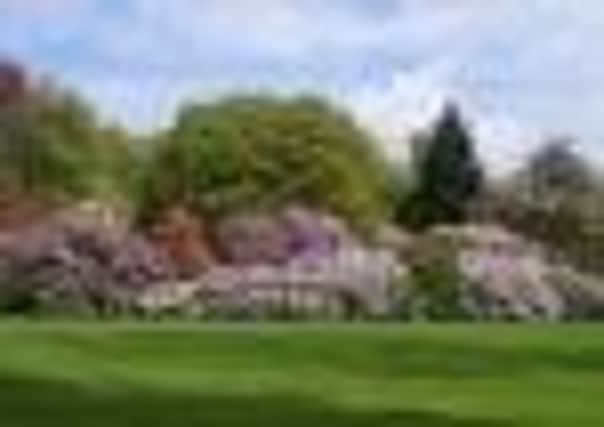Gardens: Airlie risers


What exactly sets this garden apart and lifts it out of the ordinary? Surprisingly a walk through the Airlie Woods above the village of Cortachy was to provide a valuable clue in understanding the setting.
The well-marked paths, which lead under canopies of tall trees rising cathedral-like out of the forest floor and follow the banks of the River South Esk, give an idea of what Cortachy glen might have looked like before it was transformed into a garden in the 1800s. Certainly these woods are wilder and the ground much rougher; there are no small, species trees, but the discovery of this glen helps you understand how well Cortachy garden fits into its surroundings.
Advertisement
Hide AdAdvertisement
Hide AdAlthough its boundaries have inevitably altered over time, Cortachy Estate has been in the Ogilvy family for at least 700 years. At present it consists of more than 30,000 acres, largely in glens Clova, Prosen and Moy. The family home, Cortachy Castle, which dates back to the 16th century, lies at the heart of the estate.
Situated a mile along estate roads from the creamy coloured castle, the three acre garden is divided into two parts, a semi-formal, partially-walled garden laid out with ancient yew hedges embellished with balls and cones, and an informal woodland and water garden in the lower glen, west of the formal garden.
Entered through a metal gate the garden opens up onto a wide terrace, bound to the left by a tall yew hedge with a gravel path wide enough, perhaps, to allow two or three ladies with long skirts to walk side by side. The path is framed by an extensive sweep of grass, punctuated with fruit trees and furnished with striking dark green painted wooden Versailles planters. These are cleverly set with sprays of umbrella-shaped iron plant supports used to display honeysuckle: the fresh green foliage of the plant clings to the support, before cascading down; promising wonderful summer fragrance.
The south-facing façade of the faded, 18ft-tall red brick wall is embellished with yew buttresses that divide the long walled border into manageable compartments and add much needed protection from the wind for the fruit trees and climbers espaliered up the walls.
A central yew alley leads between wide open lawns, down the gentle slope, to the foot of the garden where a large, crescent-shaped space, shaped by the curve of the river has been planted with fruit trees. To the east the garden is bound by a second yew alley, the “ladies border”, the backdrop for shrub and herbaceous borders. On this side of the garden there is also a neatly laid out space with geometrically-shaped wood-edged beds used for growing cut flowers for the house. There is also a fruit cage, mostly used for cultivating raspberries, Lady Airlie’s favourite soft fruit, says head gardener Ian Forbes.
Walking west you catch glimpses of the different trees that rise up to form the backdrop of the woodland garden, which is entered though arches of yew or simply along lower woodland paths. No matter how you enter this space, you are immediately struck by the textures, shapes and different shades of green of the trees that rise up out of the banks of the glen. The height of these mature plants is complemented by lower varieties, including Prunus, varieties of acer with claret-coloured foliage, Cercidiphyllum and a striking Styrax obassia. The fresh, feathery foliage of birch rises up above plantings of azaleas contrasting with the darker green of rhododendrons creating a rich tapestry.
In a nod to the garden’s origins as a wild glen, a fallen tree trunk, partly raised on shortened branches, has been allowed to remain in place. Lying across the first lawn, like a gigantic insect inspecting its surroundings, a fallen tree injects a note of humour.
Strategically placed throughout the glen, flowering rhododendrons introduce exotic splashes of ruby red and deep pink. The blooms of the white specimens are offset by the bronze of the bark, with this colour palette echoed in the banks of azaleas. The bank below the yew arch that leads into the garden, contrasted by plantings of white birch that emerge from the foliage, is particularly attractive.
Advertisement
Hide AdAdvertisement
Hide AdThe second thing that strikes you is the bird song: attracted by the lochan at the centre of the garden, and perhaps the water in the stone-edged burn that runs along the south side of the space, dividing just below the tall wooden pagoda that was built to celebrate the Millennium.
Adding structures to a garden, especially a wild garden can be challenging, but this blue-grey edifice is carefully placed to enhance what is already there. Its well thought-out position helps create a focal point that adds another dimension.
Perhaps the key to understanding this woodland garden is the lochan, the most magical part of the space. Here, even on a wet and grey spring day the water is illuminated by the light reflecting through the clouds and comes to life with the help of the wind playing on its surface. On a still day, however, the fringe plantings of hostas, primula, Smilacina, Mecanopsis and azaleas are reflected in the water, creating a striking mirror effect. This along with the inspired partnership between Lady Airlie and Ian Forbes is what sets this garden apart – his ability to translate her ideas and light touches into reality, allow this delightful place to withstand the test of time and remain fresh and interesting.
Cortachy Castle, By Kirriemuir is open under Scotland’s Gardens Scheme tomorrow from 2pm-6pm. A pipe band will be in attendance and ice-cream will be available; www.scotlandsgardens.org